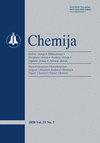金纳米粒子/碳复合材料在卤化物离子存在下电氧化葡萄糖的研究
IF 0.4
4区 化学
Q4 CHEMISTRY, MULTIDISCIPLINARY
引用次数: 0
摘要
立陶宛维尔纽斯索尔特基奥大道3号国家物理科学与技术研究所中心在本研究中,以柠檬酸钠或葡萄糖和抗坏血酸的复合混合物为还原剂,在少量不同的卤化物离子(Cl–,Br–,I–)存在下,通过化学还原法制备了碳粉负载的金纳米粒子复合材料(AuNPs/C)。使用循环伏安法评估了合成的复合材料对葡萄糖在碱性介质中的电氧化的电催化活性,而使用场发射扫描电子显微镜和电感耦合等离子体发射光谱表征了复合材料的形态和组成。电化学测量表明,与仅使用还原剂合成的复合材料相比,借助于与卤化物离子偶联的不同还原剂制备的AuNPs/C复合材料对葡萄糖的电氧化具有增强的电催化性能。在反应混合物中存在KCl、KBr或KI添加剂的情况下合成的AuNPs/C复合材料产生增加的葡萄糖电氧化电流密度值;此外,与不添加卤化物的合成复合材料相比,葡萄糖的电氧化电位向更负的值移动。本文章由计算机程序翻译,如有差异,请以英文原文为准。
Investigation of electro-oxidation of glucose at gold nanoparticles/carbon composites prepared in the presence of halide ions
State Research Institute Center for Physical Sciences and Technology, 3 Saulėtekio Avenue, 10257 Vilnius, Lithuania In this study, the carbon powder supported gold nanoparticles composites (AuNPs/C) were prepared via the chemical reduction method by employing sodium citrate or a complex mixture of glucose and ascorbic acid as reducing agents in the presence of small amounts of different halide ions (Cl–, Br–, I–). The electrocatalytic activity of the synthesized composites was evaluated for the electro-oxidation of glucose in an alkaline medium using cyclic voltammetry, whereas the morphology and composition of composites were characterized using field emission scanning electron microscopy and inductively coupled plasma optical emission spectroscopy. The electrochemical measurements demonstrate the enhanced electrocatalytic performance of the AuNPs/C composites prepared by the help of different reducing agents coupled with halide ions for the electro-oxidation of glucose as compared to that of composites that were synthesized by the use only of the reducing agents barely. The AuNPs/C composites synthesized with the presence of KCl, KBr or KI additive in the reaction mixture generate the increased glucose electro-oxidation current density values; furthermore, the glucose electro-oxidation potential is shifted to more negative values as compared to those obtained on the synthesized composites without halide additive.
求助全文
通过发布文献求助,成功后即可免费获取论文全文。
去求助
来源期刊

Chemija
化学-化学综合
CiteScore
1.30
自引率
16.70%
发文量
14
审稿时长
>12 weeks
期刊介绍:
Chemija publishes original research articles and reviews from all branches of modern chemistry, including physical, inorganic, analytical, organic, polymer chemistry, electrochemistry, and multidisciplinary approaches.
 求助内容:
求助内容: 应助结果提醒方式:
应助结果提醒方式:


